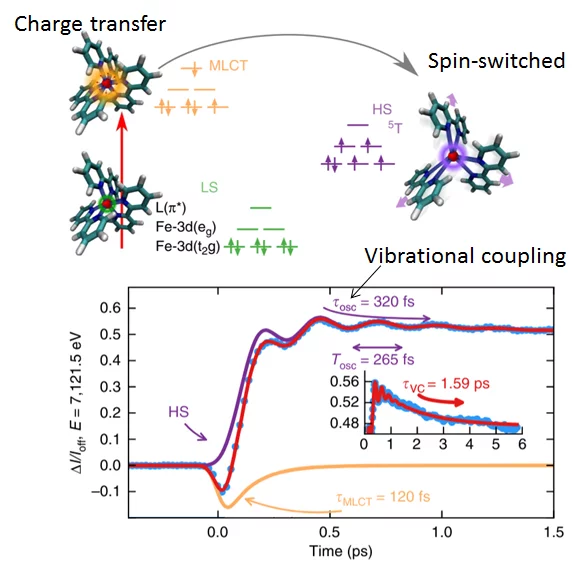Free electron lasers (FELs) like SwissFEL help scientists to understand the mechanisms that switch properties of materials which are the basis for functions in electronics, solar cells, chemistry and biology. By using ultrashort X-ray pulses it becomes possible to visualize the ultrafast rearrangements of electrons and atoms that enable the properties to switch in molecules or crystals.
An international consortium of researchers lead by Paul Scherrer Institute, Université de Rennes, and SLAC National Laboratory has now visualized the entire cascade of processes that lead to a change of the magnetic moment of electrons in a molecule within one trillionth of a second (10-12 s = 1 picosecond), using the FEL at Stanford, California (LCLS). The reaction was triggered by a visible light pulse which transferred one electron from the inside to the outside of the molecule, seen as change of electronic structure and happening faster than 1/40th of a picosecond, which was the best achievable time resolution in the experiment. After a short time (1/10th picosecond), this change switches the magnetic moment of two electrons in the molecule which causes a tension of its atoms. The measured ultrafast structural movie of atoms showed that the tension gets released by a breathing-like vibration of the entire molecule, inflating its size and bouncing back and forth to its original size. The data showed that this vibration gets damped by two different processes: Within a third of a picosecond, more vibrations of the molecule get excited which stabilizes the switched state and prevents an accidental “rewinding” or back switching. Within one picosecond, all vibrations in the molecule get transmitted to the environment around the molecule, in this case water solvent.
Understanding this process of stabilisation of the switched magnetic state may help to design new materials that either inhibit the switching and allow to harvest electric energy from the initially excited electron, or that switch very fast and efficiently in order to use the mechanism for improved information storage. SwissFEL will be able to reach even up to 10 times better time resolution which will enable to see and understand the even faster electronic and magnetic switching reactions in technically important crystalline materials. The researchers are presenting their findings in the scientific journal “Nature Communications”.
References: Henrik Lemke; henrik.lemke@psi.ch; Paul Scherrer Institut, CH-5232 Villigen PSI, Switzerland


